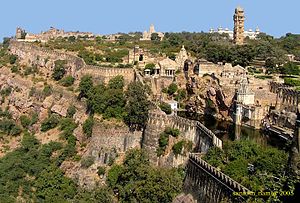Chittorgarh Fort
Chittorgarh Fort Village, Chittorgarh, Rajasthan 312001
Phone: 094137 91906
This is a World heritage site.
Chittorgarh Fort one of the largest forts in India. The fort, popularly known as Chittor, was the capital of Mewar and is today situated in Chittorgarh. It was initially ruled by Guhilot and later by Sisodias, the Suryavanshi clans of Chattari Rajputs, from the 7th century, until it was finally abandoned in 1568 after the siege by Emperor Akbar in 1567. It sprawls majestically over a hill 180 m (590.6 ft) in height spread over an area of 280 ha (691.9 acres) above the plains of the valley drained by the Berach River. The fort precinct with an evocative history is studded with a series of historical palaces, gates, temples and two prominent commemoration towers. These monumental ruins have inspired the imagination of tourists and writers for centuries.
The fort was sacked three times between the 15th and 16th centuries; in 1303 Allaudin Khilji defeated Rana Ratan Singh, in 1535 Bahadur Shah, the Sultan of Gujarat defeated Bikramjeet Singh and in 1567 Emperor Akber defeated Maharana Udai Singh II who left the fort and founded Udaipur. Each time the men fought bravely rushing out of the fort walls charging the enemy but lost every time. Following these defeats, Jauhar was committed thrice by more than 13,000 ladies and children of the Rajput heroes who laid their lives in battles at Chittorgarh Fort, first led by Rani Padmini wife of Rana Rattan Singh who was killed in the battle in 1303, and later by Rani Karnavati in 1537 AD.
Thus, the fort represents the quintessence of tribute to the nationalism, courage, medieval chivalry and sacrifice exhibited by the Mewar rulers of Sisodia and their kinsmen and women and children, between the 7th and 16th centuries. The rulers, their soldiers, the women folk of royalty and the commoners considered death as a better option than dishonor in the face of surrender to the foreign invading armies.
In 2013, at the 37th session of the World Heritage Committee held in Phnom Penh, Cambodia, Chittorgarh Fort, along with 5 other forts of Rajasthan, was declared a UNESCO World Heritage Site under the group Hill Forts of Rajasthan.
Source : Wikipedia
https://www.youtube.com/watch?v=6CwK-bJ4g6o
Reviews
The story of Rani Padmini wife of Rana Ratan Singh
It is better to engage a guide as there are lot of things to be explained. For example Rani Padmini allowed Alauddin to see her reflection on a mirror. Only a guide can explain and show you the place where Alauddin saw her reflection on a mirror.
Visiting hours : Morning to Evening all days of the week
Entry fee : Rs. 10/- for Indians and Rs. 100/- for foreign tourists



Rate this article